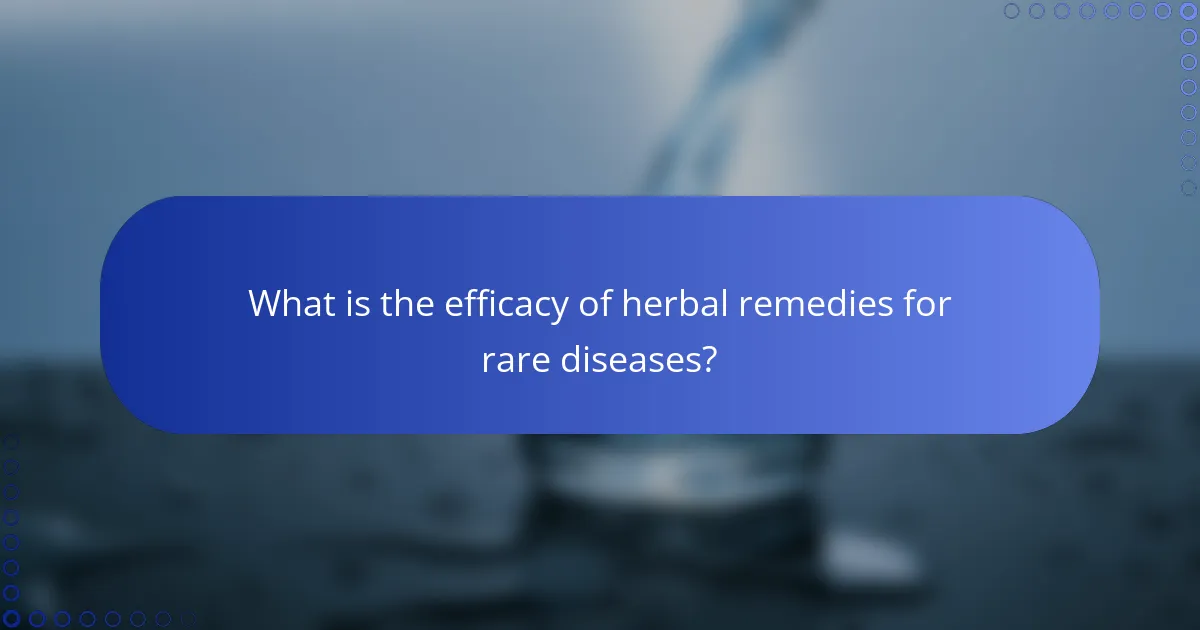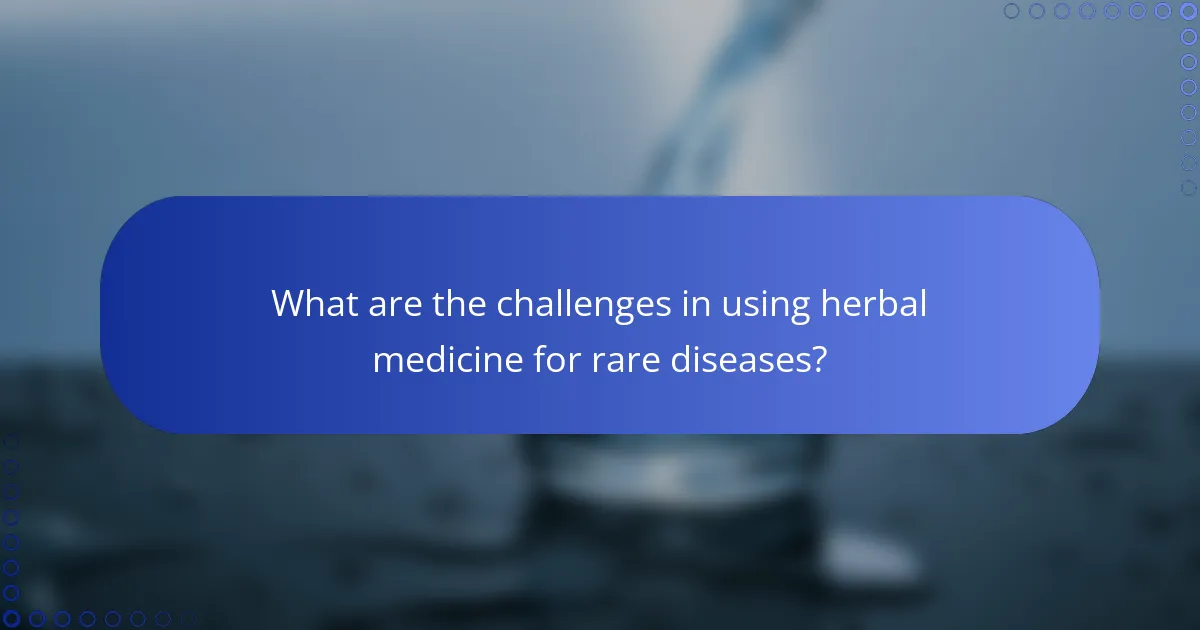Herbal medicine offers potential remedies for managing rare diseases through natural approaches. This article explores holistic assessment, the application of traditional knowledge, and the importance of scientific validation. It also examines various preparation methods and their impact on efficacy. Understanding these elements can enhance the integration of herbal treatments with conventional healthcare.

What are the core principles of herbal medicine for rare diseases?
Herbal medicine for rare diseases emphasizes natural remedies tailored to individual needs. Core principles include holistic assessment, traditional knowledge application, and scientific validation.
Holistic assessment considers physical, emotional, and environmental factors. This approach ensures remedies address the entire person, not just symptoms. Traditional knowledge guides the selection of herbs, often based on historical use for specific conditions.
Scientific validation is crucial for efficacy. Research supports the use of certain herbs, demonstrating their potential benefits in treating rare diseases. For example, studies on adaptogens show promise in enhancing resilience against rare health challenges.
Lastly, preparation methods vary significantly. Common forms include tinctures, teas, and powders, each offering unique bioavailability and absorption rates. Understanding these methods optimizes therapeutic outcomes.
How does herbal medicine differ from conventional treatments for rare diseases?
Herbal medicine offers a holistic approach to treating rare diseases, differing from conventional treatments in several key aspects. Herbal remedies often focus on enhancing overall well-being and addressing underlying imbalances, while conventional methods typically target specific symptoms through pharmaceuticals.
Preparation methods for herbal medicine include infusions, tinctures, and powders, emphasizing natural ingredients. In contrast, conventional treatments rely on synthetic compounds and standardized dosages. Efficacy can vary; some studies suggest that herbal treatments may provide benefits for certain conditions, yet they often lack the extensive clinical trials that validate conventional therapies.
Overall, the unique attribute of herbal medicine lies in its personalized approach, which contrasts with the standardized protocols of conventional treatments. This distinction can lead to different patient experiences and outcomes when managing rare diseases.
Which herbal remedies are most commonly used for rare diseases?
Herbal remedies commonly used for rare diseases include St. John’s Wort, Ginkgo Biloba, and Turmeric. These herbs may help alleviate symptoms and improve quality of life. St. John’s Wort is often used for mood disorders, while Ginkgo Biloba may enhance cognitive function. Turmeric is recognized for its anti-inflammatory properties, which can benefit various conditions. Each remedy’s efficacy varies based on individual response and preparation methods.
What are the benefits of using herbal medicine for rare diseases?
Herbal medicine offers several benefits for rare diseases, including natural remedies, potential efficacy, and fewer side effects. These treatments often utilize unique plant compounds that may target specific symptoms or underlying causes of rare conditions. For example, some herbs have demonstrated anti-inflammatory properties, which can alleviate discomfort associated with certain rare diseases. Additionally, preparation methods such as teas, tinctures, or capsules allow for versatile intake options, catering to individual preferences. Overall, herbal medicine can serve as a complementary approach to conventional treatments, enhancing patient care and quality of life.
How do herbal medicines interact with other treatments?
Herbal medicines can interact with other treatments, potentially enhancing or diminishing their effects. These interactions may vary based on the unique attributes of the herbal remedy and the conventional treatment involved. For example, St. John’s Wort can reduce the efficacy of certain antidepressants. Understanding these interactions is crucial for ensuring safe and effective treatment plans for rare diseases. Always consult healthcare providers before combining herbal remedies with other therapies.

What preparation methods are used for herbal remedies?
Common preparation methods for herbal remedies include infusions, decoctions, tinctures, and poultices. Infusions involve steeping herbs in hot water, while decoctions require boiling tougher plant materials. Tinctures are alcohol-based extracts, and poultices apply crushed herbs directly to the skin. Each method extracts different compounds, enhancing efficacy for various rare diseases.
How are herbal extracts made for treating rare diseases?
Herbal extracts for treating rare diseases are made through processes like maceration, percolation, or infusion. These methods involve soaking plant materials in solvents to extract beneficial compounds. The efficacy of these extracts depends on the plant’s unique attributes and preparation techniques. For example, the extraction duration and solvent type can significantly affect the concentration of active ingredients.
What are the differences between tinctures, teas, and capsules?
Tinctures, teas, and capsules differ in preparation, dosage, and absorption rates. Tinctures are concentrated herbal extracts made by soaking herbs in alcohol or vinegar, allowing quick absorption. Teas are brewed from dried herbs, offering a gentler effect and slower absorption. Capsules contain powdered herbs, providing a consistent dosage with delayed effects. Each method serves distinct needs in herbal medicine for rare diseases.
Which preparation methods are considered most effective?
The most effective preparation methods for herbal medicine include infusion, decoction, tincture, and poultice. Each method extracts active compounds differently, enhancing the efficacy of remedies for rare diseases.
Infusion involves steeping herbs in hot water, ideal for delicate leaves and flowers. Decoction requires boiling tougher plant parts, extracting deeper flavors and benefits. Tinctures utilize alcohol to extract potent compounds, ensuring longer shelf life and concentrated effects. Poultices apply crushed herbs directly to the skin, providing localized relief.
These methods can be tailored to the specific attributes of the herbs used, maximizing their therapeutic potential.
How do regional practices influence herbal preparation methods?
Regional practices significantly influence herbal preparation methods by integrating local knowledge, climate, and available resources. Traditional techniques vary, reflecting cultural beliefs and historical usage. For instance, some regions may emphasize drying herbs, while others prefer tinctures or poultices. These methods enhance the efficacy of herbal remedies tailored to specific rare diseases prevalent in those areas. Local flora also dictates preparation styles, ensuring that remedies align with the unique attributes of the region’s plants.

What is the efficacy of herbal remedies for rare diseases?
Herbal remedies can offer potential benefits for managing rare diseases, but their efficacy varies widely. Research indicates that certain herbs may alleviate symptoms or enhance treatment outcomes for specific conditions. For example, turmeric shows promise in reducing inflammation, while ginseng may support immune function.
The preparation methods of herbal remedies, such as teas, tinctures, or capsules, can influence their effectiveness. Standardization of dosages remains a challenge, impacting the reliability of results.
Clinical studies on herbal efficacy for rare diseases are limited, necessitating more rigorous research. Individual responses to herbal treatments can differ, highlighting the need for personalized approaches.
Overall, while herbal remedies may complement conventional treatments, they should be approached cautiously and discussed with healthcare providers for safety and efficacy.
How is the effectiveness of herbal medicine evaluated?
The effectiveness of herbal medicine is evaluated through clinical studies, traditional usage, and pharmacological analysis. Clinical trials assess safety and efficacy in treating rare diseases. Traditional knowledge provides insights into long-standing practices, while pharmacological analysis examines active compounds and their mechanisms. These methods collectively contribute to understanding the therapeutic potential of herbal remedies.
What clinical studies support the use of herbal remedies for specific rare diseases?
Clinical studies demonstrate the efficacy of herbal remedies for specific rare diseases. Research indicates that certain herbs, such as turmeric and ashwagandha, may alleviate symptoms associated with rare conditions like fibrodysplasia ossificans progressiva. A study published in the Journal of Ethnopharmacology found that turmeric’s active compound curcumin exhibits anti-inflammatory properties beneficial for managing rare inflammatory diseases. Additionally, ashwagandha has shown promise in improving quality of life for patients with rare autoimmune disorders, as noted in clinical trials. These findings support the integration of herbal medicine in treatment protocols for rare diseases.
What factors influence the efficacy of herbal treatments?
The efficacy of herbal treatments is influenced by several key factors. These include the quality of the herbs, preparation methods, dosage, individual patient characteristics, and the specific disease being treated. High-quality herbs often have higher concentrations of active compounds, enhancing efficacy. Preparation methods, such as tinctures or teas, can affect bioavailability. Dosage must be appropriate to achieve therapeutic effects without adverse reactions. Individual factors, including genetics and existing health conditions, can also impact how herbs work in the body. Lastly, the nature of the rare disease plays a crucial role in determining treatment outcomes.

What are the challenges in using herbal medicine for rare diseases?
Herbal medicine for rare diseases faces several challenges, including limited scientific research, variability in efficacy, and potential interactions with conventional treatments. The lack of standardized preparation methods complicates dosage and consistency. Additionally, regulatory hurdles may restrict access to certain herbal remedies.
How do regulatory issues affect the use of herbal remedies?
Regulatory issues significantly limit the use of herbal remedies. These regulations affect product availability, safety standards, and efficacy claims. For instance, strict guidelines can restrict the sale of certain herbs, impacting rare disease treatments. Additionally, varying regulations across regions create inconsistencies in access and quality assurance. This regulatory landscape shapes consumer trust and influences research funding for herbal medicine.
What are the common misconceptions about herbal medicine?
Many misconceptions exist about herbal medicine, particularly regarding its effectiveness for rare diseases. One common myth is that all herbal remedies are safe and effective, which overlooks potential side effects and interactions. Another misconception is that herbal medicine can replace conventional treatments entirely, ignoring the importance of evidence-based medical care. Additionally, some believe that herbal remedies work instantly, while many require consistent use over time to show results. Lastly, the idea that all herbs are equally potent is misleading, as the quality and concentration can vary significantly.
What risks are associated with using herbal remedies?
Using herbal remedies can pose risks such as adverse reactions, interactions with medications, and insufficient regulation. These risks can lead to serious health issues, especially for individuals with rare diseases.
Adverse reactions may occur due to unique attributes of specific herbs, which can vary widely. For example, St. John’s Wort can interact negatively with antidepressants, affecting their efficacy.
Lack of standardization in herbal preparations can result in variable potency and purity, posing a rare attribute risk. Consumers may not receive the intended therapeutic effects or may experience unexpected side effects.
Additionally, individuals with rare diseases may have unique vulnerabilities, making it crucial to consult healthcare professionals before using herbal remedies. This ensures safety and effectiveness tailored to their specific conditions.

How can patients safely integrate herbal medicine into their treatment plans?
Patients can safely integrate herbal medicine by consulting healthcare professionals and ensuring compatibility with existing treatments. Start by discussing herbal options with a doctor to avoid interactions.
Choosing reputable sources for herbal products is crucial. Look for standardized extracts and verified quality to ensure efficacy. Gradually introduce herbs into the treatment plan, monitoring for side effects.
Document any changes in symptoms or reactions to assess the impact of herbal remedies. This systematic approach helps to safely incorporate herbal medicine alongside conventional treatments.
Educating oneself about specific herbs is essential. Understanding their unique attributes, such as potential benefits and risks, enhances informed decision-making in treatment plans.
What guidelines should patients follow when choosing herbal remedies?
Patients should prioritize safety and efficacy when choosing herbal remedies. First, consult with healthcare professionals to ensure compatibility with existing treatments. Next, research the specific herbal remedy’s preparation methods and documented benefits. Additionally, consider sourcing from reputable suppliers to avoid contamination. Finally, monitor for any adverse reactions during use.
How can patients work with healthcare providers to use herbal medicine effectively?
Patients can effectively collaborate with healthcare providers to use herbal medicine by maintaining open communication and sharing their health goals. They should provide detailed information about their conditions and any other treatments they are undergoing. This transparency allows providers to recommend suitable herbal remedies that align with the patient’s unique health profile. Additionally, patients should inquire about preparation methods and dosages, ensuring they understand the efficacy and safety of the herbal treatments. Regular follow-ups with healthcare providers can help monitor progress and adjust the use of herbal medicine as needed.
What are the best practices for sourcing high-quality herbal products?
To source high-quality herbal products, prioritize reputable suppliers and third-party testing. Look for certifications that ensure purity and potency. Consider the sourcing location, as some regions produce superior herbs. Evaluate preparation methods to ensure they retain efficacy. Be aware of unique attributes, such as organic or wildcrafted labels, which can indicate higher quality.
What common mistakes should be avoided when using herbal medicine for rare diseases?
When using herbal medicine for rare diseases, avoid common mistakes such as improper dosage, neglecting professional advice, and overlooking interactions with conventional medications. Understanding the unique attributes of each herb is crucial for efficacy. Always consider individual health conditions and potential rare side effects.